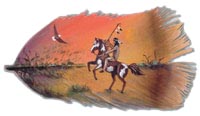
Tiny universe: Formal societies of miniaturists have a lot of rules. And Rita Dils of Burnsville, who applies acrylic paint to feathers, doesn’t necessarilt follow them.
|
****************************************************************** Connie Bostic
It’s easy to feel like Gulliver in Lilliput in the gallery at Black Mountain Center for the Arts.
The Center is hosting its sixth-annual exhibit of miniature art. Accordingly, no less than 120 works are on display.
Entries arrived from all parts of the U.S., and some from England. But if the show’s dimensions are small, its themes are writ (or rather painted, sculpted and assembled) large: We see everything from landscape and still life to portraiture and animals (wild and domestic).
Miniatures historically appeared as the capital letter introducing an illuminated manuscript. Once the printing press was invented, though, the skill of the dedicated monks who toiled over these elaborate letters dropped into obscurity, and eventually the genre evolved into portraiture. The tiny likenesses of loved ones could be carried about as we today might hold onto a wallet photo. In fact, the advent of photography — making a likeness more accurate and much less expensive — almost killed the art of the miniature.
But the 20th century saw a rekindling of interest in the form, and societies of miniaturists were organized in many parts of the world. These groups employ very exacting standards, hard-and-fast rules governing their members and their work. Some are more stringent than others, but most groups seem to agree on a few basics: A subject must be rendered no more than one-sixth of its actual size; the whole work cannot exceed 100 square centimeters or 16 square inches when the dimensions are added together; and the human head must be no more than two inches high.
Black Mountain Center Director Gale Jackson admits that the local exhibit strives for “the spirit” of miniaturization — meaning it doesn’t adhere to the stricter guidelines (the better, she says, to encourage wider participation).
Early miniatures were made using oil paints on ivory. Today, the only ivory available comes from old piano keys, actually used by some of the exhibiting artists. But generally, media is even more varied than subject matter. We see oil paint on ivorine (a synthetic ivory), watercolor, acrylic, soft pastel, colored pencil, pen and ink, ink wash, etching, linocut, encaustic and collage. A local artist, Rita Dils of Burnsville, uses the most surprising medium — acrylic paint on feathers — to render a deer, a buffalo, and a Native American man on a rearing Paint horse. Her colors are intense in these works, but quieter in her depiction of a hummingbird visiting a flower.
Then there’s England’s Cyril B. Turner — a stickler for all the rules. His landscapes look exactly like itty-bitty Thomas Kinkade paintings. More sweet nostalgia comes from Ted Daubresse of Sun City Center, Fla., who shows a 3″ x 5″ painting of a fishing shack with a tattered lace curtain in the window; the pattern in the lace spells out “Home Sweet Home” in reverse.
Roosters make a surprisingly strong showing, the most interesting one coming from Marva Simpson. In this 2″ x 6″ piece, the cock is shown from the back, his tail sweeping like the long gown of an early-20th-century socialite painted by Sargent or Whistler.
Carol Reinhardt’s collages are great fun: She uses tiny slivers of cream-colored paper to represent tree trunks and branches, and bits of yellow tissue paper for leaves. Her “Dutch Bulb”‘s roots have been painstakingly assembled from thread.
True, you may not exit the gallery thinking you’ve seen great art — unless obsessive detail can be considered an ingredient of greatness. Come equipped with a magnifying glass, and at least you won’t leave unimpressed.
[Connie Bostic is an Asheville-based artist and writer.]
The 6th Annual Juried International Miniature Art Exhibit and Sale at Black Mountain Center for the Arts (225 West State St.) runs through Saturday, Jan. 29. 669-0930.



Before you comment
The comments section is here to provide a platform for civil dialogue on the issues we face together as a local community. Xpress is committed to offering this platform for all voices, but when the tone of the discussion gets nasty or strays off topic, we believe many people choose not to participate. Xpress editors are determined to moderate comments to ensure a constructive interchange is maintained. All comments judged not to be in keeping with the spirit of civil discourse will be removed and repeat violators will be banned. See here for our terms of service. Thank you for being part of this effort to promote respectful discussion.